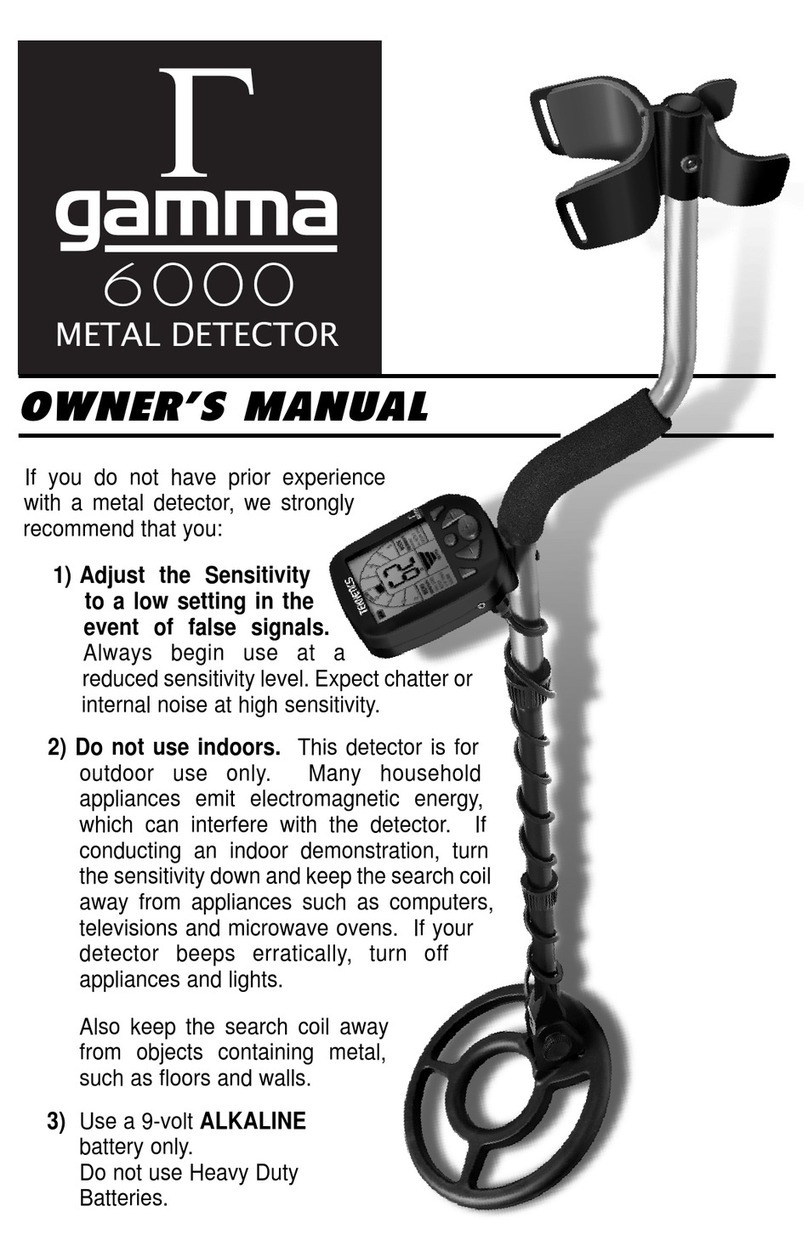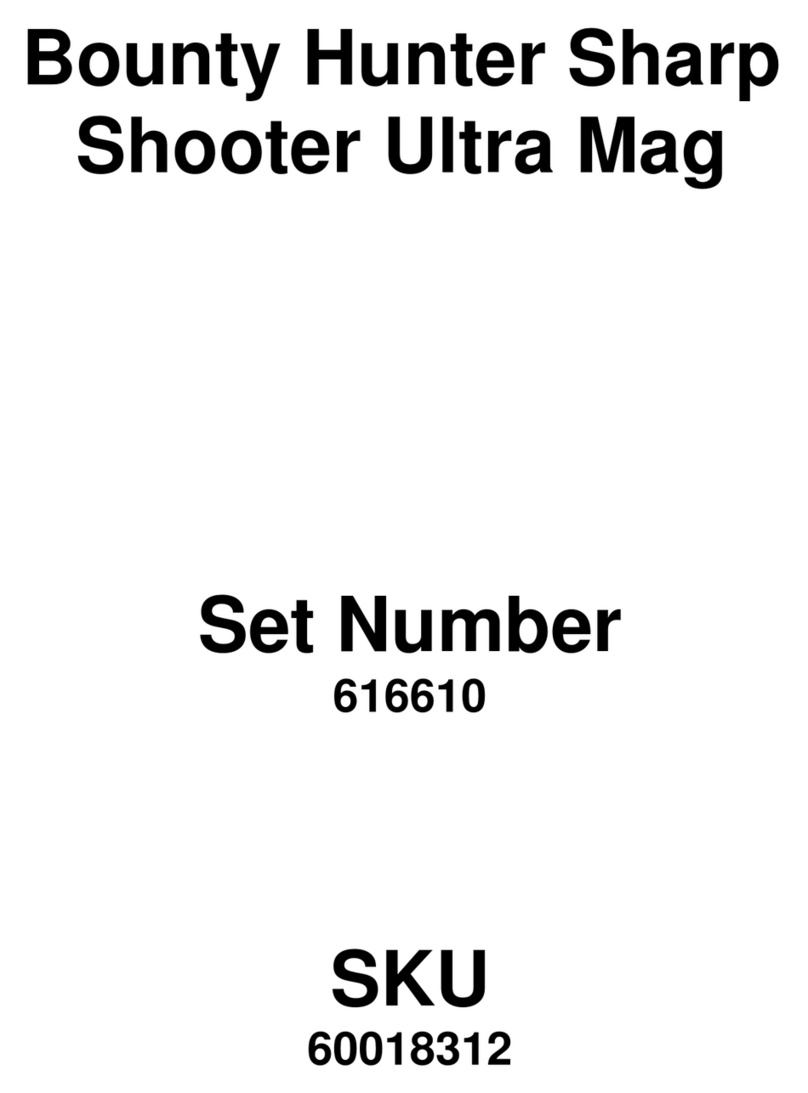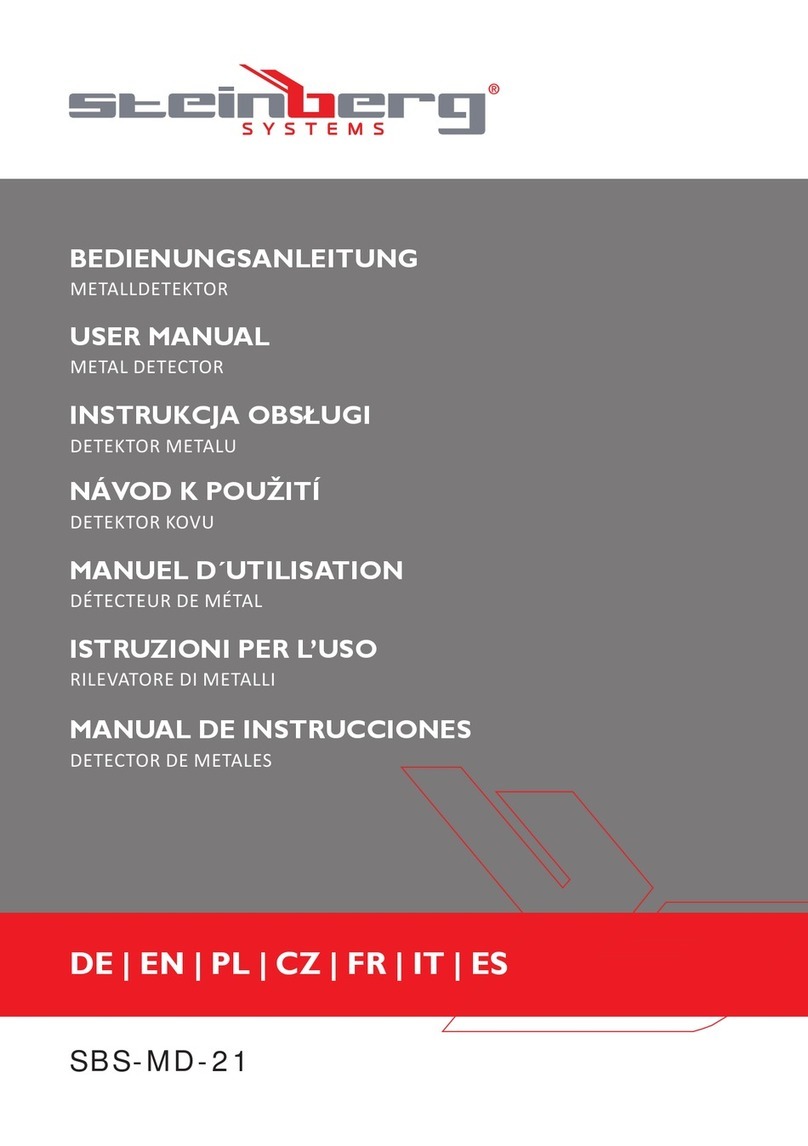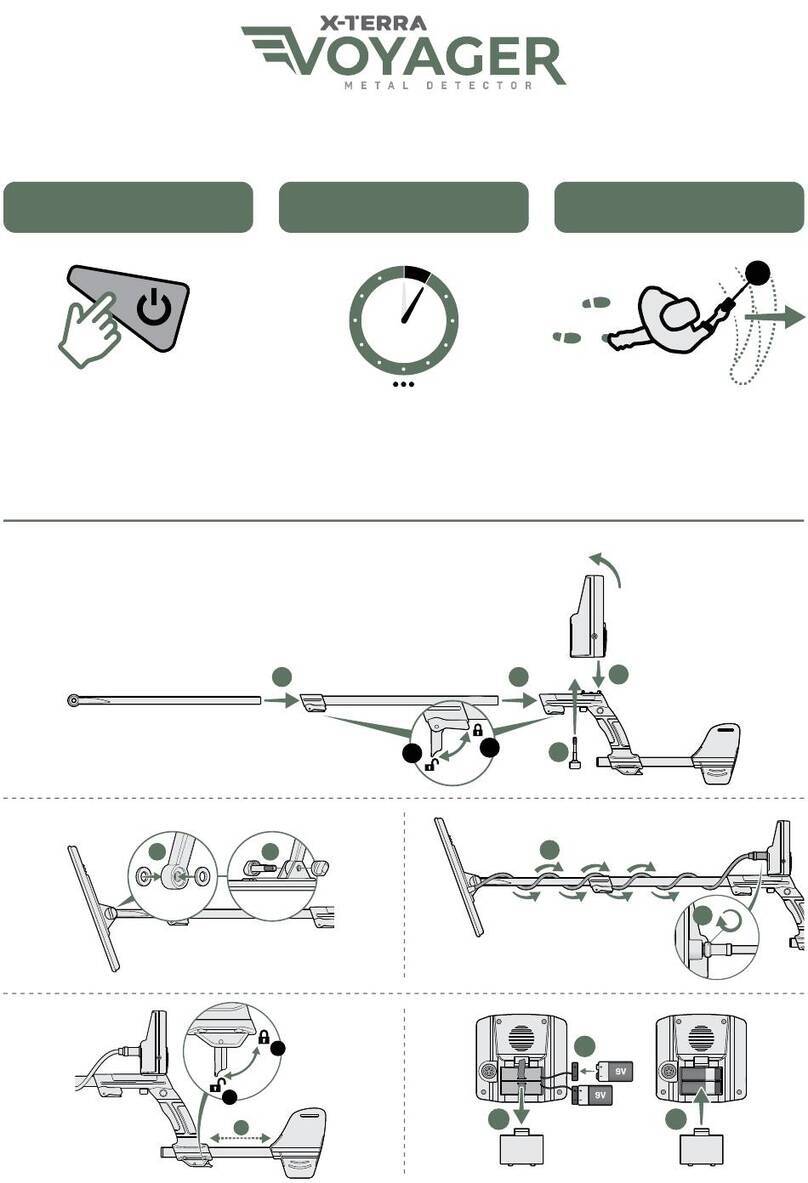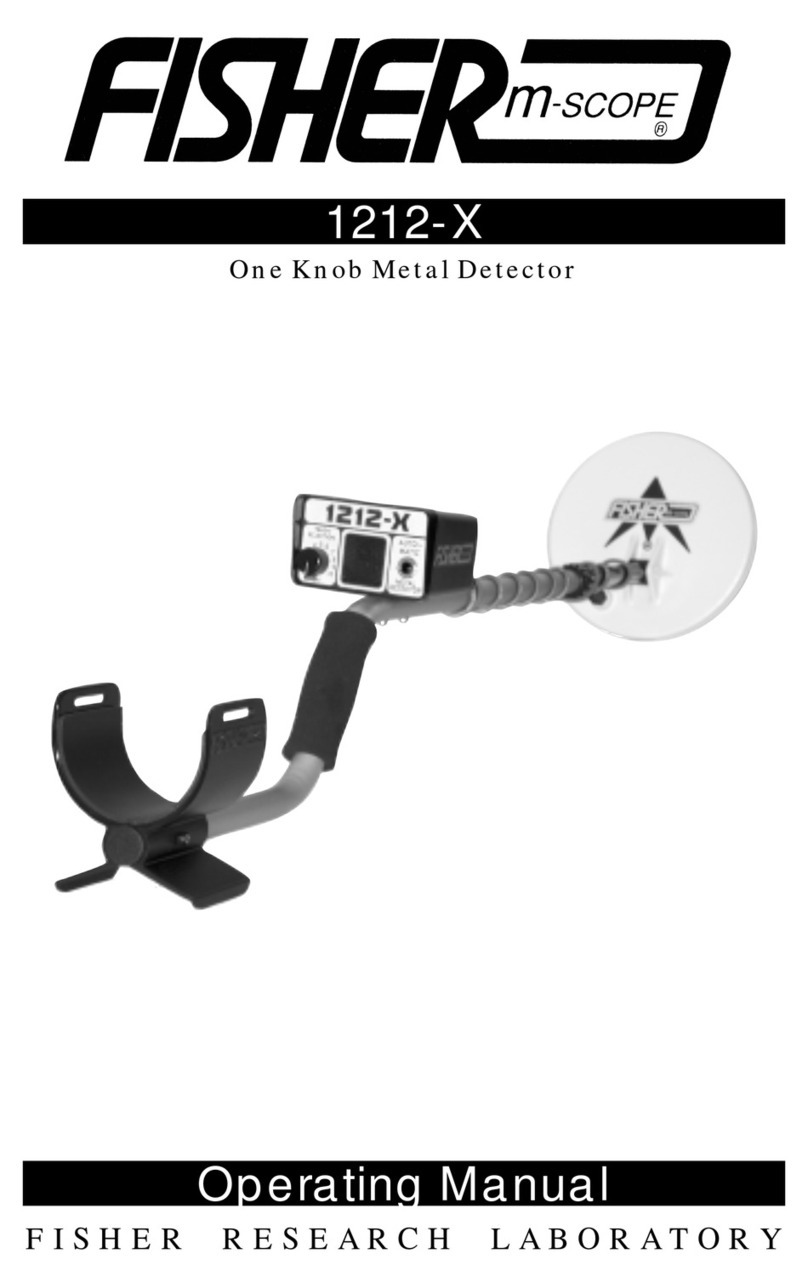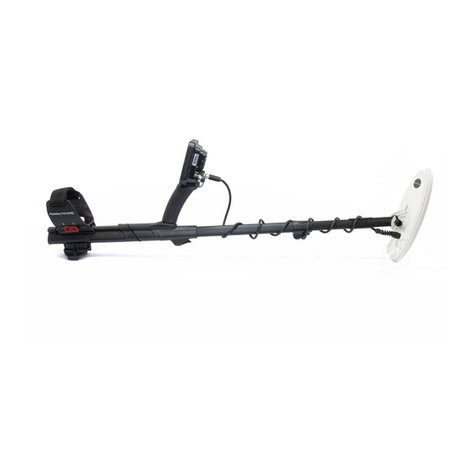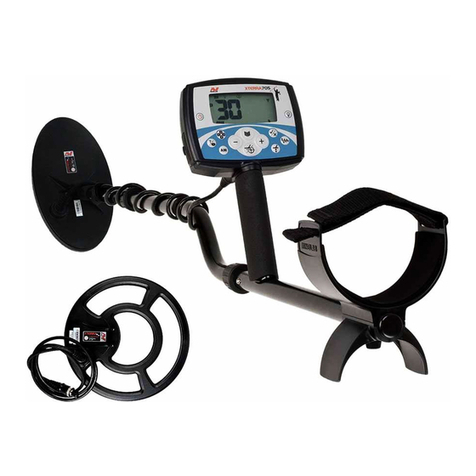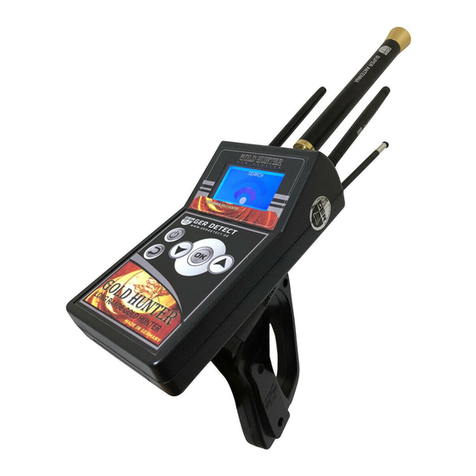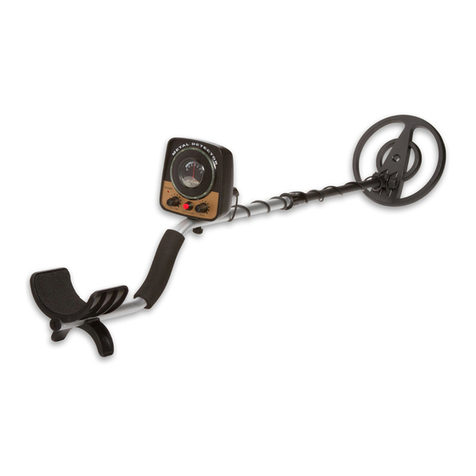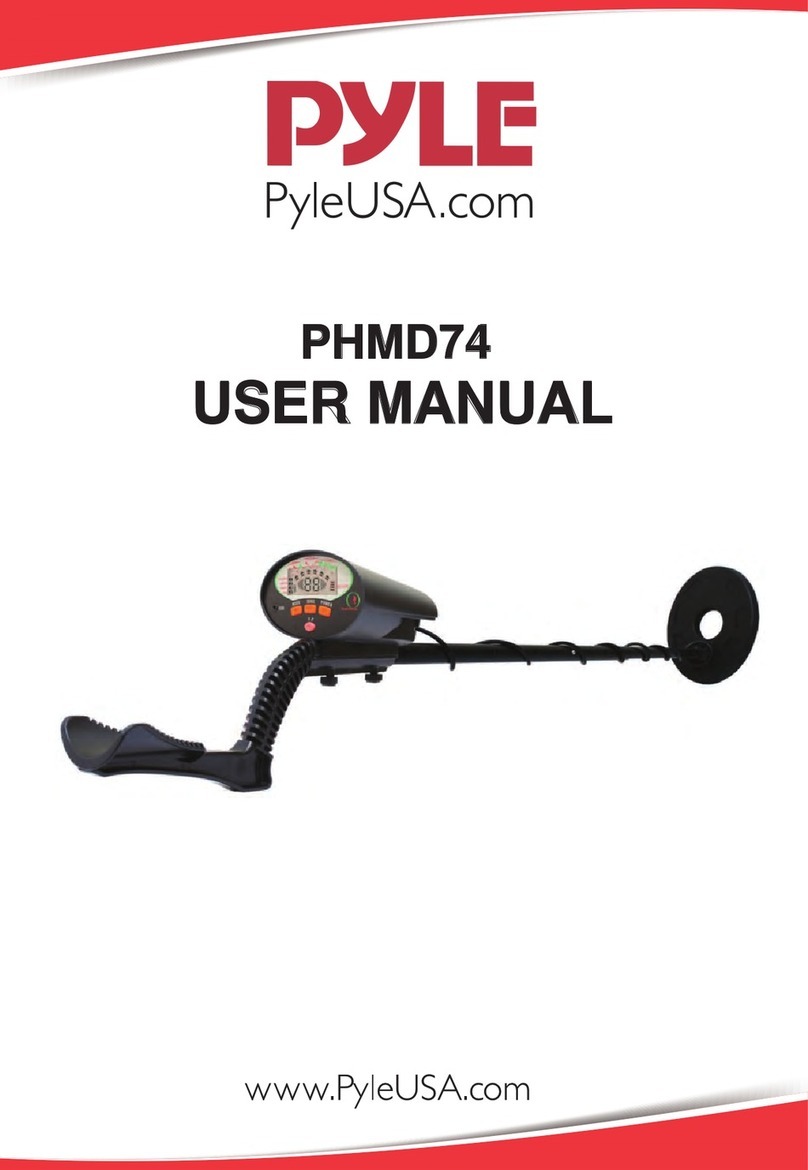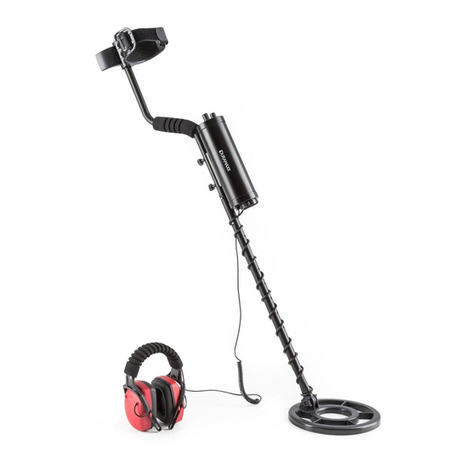First Texas Products Gold User manual

First Texas Products L.L.C.
1465-H Henry Brennan Dr.
El Paso, TX 79936
(915) 633-8354
Copyright©2010 by First Texas Products, L.L.C.
According to FCC part 15.21 Changes or Modifications made to this device not expressly approved by the party responsible for
compliance could void the users authority to operate this equipment.
All rights reserved, including the right to reproduce this book, or parts thereof, in any form,
except for the inclusion of brief quotations in a review.
Published by First Texas Products, L.L.C.
Gold®Metal Detector is a registered trademark of First Texas Products, L.L.C.
www.detecting.com
Warranty coverage does not include the cost of transporting the detector back to an owner
who is located outside of the continental United States of America.
5-YEAR LIMITED WARRANTY
The GOLD metal detector is warranted against defects in materials and
workmanship under normal use for five years from the date of purchase
to the original owner.
Damage due to neglect, accidental damage, or misuse of this product is
not covered under this warranty. Decisions regarding abuse or misuse of
the detector are made solely at the discretion of the manufacturer.
Proof of Purchase is required to make a claim under this warranty.
Liability under this Warranty is limited to replacing or repairing, at our option,
the metal detector returned, shipping cost prepaid to First Texas Products.
Shipping cost to First Texas Products is the responsibility of the consumer.
To return your detector for service, please first contact First Texas for a
Return Authorization (RA) Number. Reference the RA number on your
package and return the detector within 15 days of calling to:
MGLD14 041311
METAL DETECTOR
OWNER’S MANUAL
If you do not have
prior experience with a
metal detector, we
strongly recommend that you:
1) Adjust the Sensitivity to a low setting
in the event of false signals. Always begin
use at a reduced sensitivity level; increase to
full sensitivity after you have become familiar
with the detector.
2) Do not use indoors. This detector is for outdoor use
only. Many household appliances emit electromagnetic energy,
which can interfere with the detector. If conducting an indoor
demonstration, turn the sensitivity down and keep the search coil
away from appliances such as computers, televisions and
microwave ovens. If your detector beeps erratically, turn off
appliances and lights.
Also keep the search coil away from objects containing metal, such
as floors and walls.
3) Use a 9-volt ALKALINE battery only.
Do not use Heavy Duty Batteries.
TREASURE HUNTER’S CODE OF ETHICS:
• Always check Federal, State, County and local laws before searching.
• Respect private property and do not enter private property without the owner’s permission.
• Take care to refill all holes and leave no damage.
• Remove and dispose of any and all trash and litter found.
• Appreciate and protect our inheritance of natural resources, wildlife and private property.
• Act as an ambassador for the hobby, use thoughtfulness, consideration and courtesy at all times.
• Never destroy historical or archaeological treasures.
• All treasure hunters may be judged by the example you set; always conduct yourself with
courtesy and consideration of others

2
TABLE OF CONTENTS
Terminology . . . . . . . . . . . . . . . . . . . . . . . . . . . . . . . . . . . . . .3
Assembly . . . . . . . . . . . . . . . . . . . . . . . . . . . . . . . . . . . . . . .4-5
Batteries . . . . . . . . . . . . . . . . . . . . . . . . . . . . . . . . . . . . . . . . .6
Quick-Start Demo . . . . . . . . . . . . . . . . . . . . . . . . . . . . . . . . . .8
Basic Of Metal Detecting . . . . . . . . . . . . . . . . . . . . . . . . . . .8-9
Ground Minerals . . . . . . . . . . . . . . . . . . . . . . . . . . . . . . .8
Trash . . . . . . . . . . . . . . . . . . . . . . . . . . . . . . . . . . . . . . . .8
Identifying Buried Objects . . . . . . . . . . . . . . . . . . . . . . .8
Size and Depth of Buried Objects . . . . . . . . . . . . . . . . . .9
EMI . . . . . . . . . . . . . . . . . . . . . . . . . . . . . . . . . . . . . . . . .9
How To Work The Controls . . . . . . . . . . . . . . . . . . . . . . . . . .10
MENU Selections
Disc Level . . . . . . . . . . . . . . . . . . . . . . . . . . . . . . . . . . .11
Notch . . . . . . . . . . . . . . . . . . . . . . . . . . . . . . . . . . . . . .11
Sensitivity . . . . . . . . . . . . . . . . . . . . . . . . . . . . . . . . . . .12
Volume . . . . . . . . . . . . . . . . . . . . . . . . . . . . . . . . . . . . .12
Target Identification . . . . . . . . . . . . . . . . . . . . . . . . . . . . . . .13
Depth And Target Display . . . . . . . . . . . . . . . . . . . . . . . . . . .14
In The Field Techniques . . . . . . . . . . . . . . . . . . . . . . . . . .15-17
Headphones . . . . . . . . . . . . . . . . . . . . . . . . . . . . . . . . . . . . .18
Trouble Shooting . . . . . . . . . . . . . . . . . . . . . . . . . . . . . . . . . .19
Code of Ethics . . . . . . . . . . . . . . . . . . . . . . . . . . . . .Back Cover
Warranty . . . . . . . . . . . . . . . . . . . . . . . . . . . . . . . . .Back Cover
19
TROUBLE SHOOTING GUIDE
SYMPTOM CAUSE SOLUTION
Detector chatters • Using detector • Use detector
or beeps erratically indoors outdoors only
• Using detector near • Move away
power lines
from power lines
• Using 2 detectors in • Keep 2 detectors
close proximity at least 20’ apart
• Environmental •
Reduce sensitivity
electromagnetic until erratic
interference signals cease
Constant low tone •
Discharged battery
• Replace battery
or
constant repeating
tones
• Wrong type of • Use only 9V
battery alkaline battery
or rechargeable
LCD does not lock • Multiple targets •
Move coil slowly
on to one target ID present at different angles
or detector emits • Highly oxidized • Only dig up
multiple tones target repeatable signals
• Sensitivity set • Reduce sensitivity
too high
No power, no • Dead battery • Replace battery
sounds
• Cord not connected
securely •
Check connections
TROUBLE SHOOTING

TERMINOLOGYHEADPHONE JACKS
The following terms are used throughout the manual, and are standard
terminology among detectorists.
ELIMINATION
Reference to a metal being "eliminated" means that the detector will
not emit a tone, nor light up an indicator, when a specified object
passes through the coil’s detection field.
DISCRIMINATION
When the detector emits different tones for different types of metals,
and when the detector "eliminates" certain metals, we refer to this
as the detector "discriminating" among different types of metals.
Discrimination is an important feature of professional metal
detectors. Discrimination allows the user to ignore trash and
otherwise undesirable objects.
RELICA relic is an object of interest by reason of its age or its association
with the past. Many relics are made of iron, but can also be made
of bronze or precious metals.
IRON Iron is a common, low-grade metal that is an undesirable target in
certain metal detecting applications. Examples of undesirable iron
objects are old cans, pipes, bolts, and nails.
Sometimes, the desired target is made of iron. Property markers,
for instance, contain iron. Valuable relics can also be composed of
iron; cannon balls, old armaments, and parts of old structures and
vehicles can also be composed of iron.
FERROUS
Metals which are made of, or contain, iron.
PINPOINTING
Pinpointing is the process of finding the exact location of a buried
object. Long-buried metals can appear exactly like the surrounding
soil, and can therefore be very hard to isolate from the soil.
PULL-TABS
Discarded pull-tabs from beverage containers are the most bothersome
trash items for treasure hunters. They come in many different shapes
and sizes. Pull-tabs can be eliminated from detection, but some other
valuable objects can have a magnetic signature similar to pull-tabs, and
will also be eliminated when discriminating out pull-tabs.
GROUND BALANCE
Ground Balancing is the ability of the detector to ignore, or "see
through," the earth’s naturally occurring minerals, and only sound
a tone when a metal object is detected. This Detector incorporates
proprietary circuitry to eliminate false signals from severe ground
conditions 3
18
Headphone
Jacks
The detector has both 1/8” & 1/4” headphone jacks on the left side of the housing.
Optional Headphones come standard with a 1/4” stereo plug and a 1/4”-
to-1/8” adaptor.
When the headphone jack is connected, speaker audio is disabled..
USING HEADPHONES
Using a detector with headphones facilitates detection of the weakest sig-
nals and also extends the battery life.
It also allows you to hear subtle changes in the sound more clearly, particular-
ly if searching in a noisy location. For safety reasons, do not use headphones
near traffic or where other dangers are present. This device is to be used with
interconnecting cables/headphone cables shorter than three meters.

17
4
ASSEMBLY
Assembly is easy and
requires no tools.
●
1Loosen both Locking Collars by
rotating 100% counterclockwise.
●
2Insert the Upper Stem into the S-Rod and click
Silver Button into hole.
●
3Position the Lower Stem with the
Silver Button toward the back. Using
the Bolt and Knurled Knob, attach the
Search Coil to the Lower Stem.
●
4Press the button on the upper end of
the Lower Stem and slide the Lower
Stem in to the Upper Stem.
Adjust the stem to a length that
lets you maintain a comfortable
upright posture, with your arm relaxed
at your side, and the search coil
parallel to the ground in front of
you.
●
5Wind the cable securely
around the stems.
●
6Insert the plug into the matching
connector on the back of the detector
body. Be sure that the key-way and
pins line up correctly.
●
7Tighten both Locking Collars.
●
8Secure the cable with the 2 velcro straps
provided, one on the Lower Stem close to
the coil, one on the Upper Stem, close to
the housing.
Caution: Do not force the plug in. Excess
force will cause damage. To
disconnect the cable, pull on the
plug.
Do not pull on the cable.
Locking
Collar S-Rod
Velcro
Strap
Velcro
Strap
Knurled
KnobBolt
Serch
Coil
Hand-grip
Search
Coil Cable
Cable
Plug
Locking
Collar
Upper
Stem
angles, you may have
encountered multiple objects.
If you are new to the hobby,
you may want to dig all targets
at first. With practice in the
field, you will learn to better
discern the nature of buried
objects by the nature of the
detector’s response.
You may encounter some false
signals as you proceed. False
signals occur when the detector
beeps, but no metal target is
present. False signals can be
induced by electromagnetic
interference, oxidation, or
highly mineralized ground
soils. If the detector beeps
once, but does not repeat the
signal with several additional
sweeps over the same spot,
there is probably no target
present.
When searching very trashy
ground, it is best to scan small
areas with slow, short sweeps.
You will be surprised just how
much trash metal and foil you
will find in some areas. The
trashiest areas have been
frequented by the most people,
and frequently hold the most
promise for finding the most
lost valuables.
Also maintain the search coil
positioned just above the
surface of the ground, without
making contact with the
ground. Making contact with
the ground can cause false
signals.
IN THE FIELD TECHNIQUES
(continued)

5
ASSEMBLY
IN THE FIELD TECHNIQUES
(continued)
Adjusting the Arm Rest
The arm rest may be moved
forward or backwards by
removing the single screw and
nut, and then repositioning the
2-piece arm rest. Users with
shorter arms may find the arm
rest more comfortable in the
forward position. In order to
move the arm rest backwards,
the plastic plug must be
removed from the aluminum
tube.
Arm Rest Strap (not included)
Some users prefer to use a strap
when swinging the detector
vigorously, in order to hold the
detector secure against the arm.
The strap may be purchased as
an optional accessory.
The detector can also be used
without the strap with no
compromise to detector balance
and stability under most
conditions.
Battery
Compartment
(back side)
Search Coil
Knurled
Knob
Hand-grip
Nut
Screw
Search
Coil
Cable
Cable
Plug
S-Rod
armrest
Velcro
Strap
Locking
Collar
Locking
Collar
Upper
Stem
1/8” Headphone Jack
1/4” Headphone Jack
Optional Arm Strap
Swing the search coil slowly,
overlapping each sweep as you
move forward. It is important
to sweep the coil at a consistent
speed over the ground as you
search. After identifying a
target, your sweep technique
can help in identifying both the
location and the nature of the
target. If you encounter a weak
signal, try moving the coil in
short, rapid sweeps
over the target zone;
such a short rapid
sweep may provide
a more consistent
target
identification.
Most
worthwhile
objects
will
respond with a repeatable tone.
If the signal does not repeat
after sweeping the coil directly
over the suspected target a few
times, it is more than likely
trash metal.
Crossing the target zone with
multiple intersecting sweeps at
multiple angles is another way
to verify the repeatability of the
signal, and the potential of the
buried target. To use this
method, walk around the target
area in a circle, sweeping the
coil across the target
repeatedly, every 30 to 40
degrees of the circle, about ten
different angles as you walk
completely around the target.
If a high-tone target completely
disappears from detection at a
given angle, chances are that
you are detecting oxidized
ferrous metals, rather than a
silver or copper object. If the
tone changes at different
WHAT
READS
LIKE THIS
…MAY
ACTUALLY
BE THIS
16

6
The detector requires a single 9-volt ALKALINE battery (battery not included).
Do not use ordinary zinc carbon batteries.
Rechargeable batteries can also be used.
If you wish to use rechargeable batteries, we recommend using a
Nickel Metal Hydride rechargeable battery.
The battery compartment is located on the back side of the housing.
Slide the battery door to the side and remove it to expose the battery
compartment.
BATTERY LIFE
Expect 20 to 25 hours of life from a 9-volt alkaline battery.
Rechargeable batteries provide about 8 hours of usage per charge.
SPEAKER VOLUME AND BATTERY CHARGE
You may notice the speaker volume drop while one battery segment is
illuminated.
With one segment flashing, low speaker volume will be very apparent.
BATTERY INDICATOR
The 3-segment battery indicator has 4 stages of indication.
These indications are accurate for a 9-volt alkaline battery.
Segments Illuminated Battery Voltage
3 -segments more than 8.3 volts
2 -segments more than 7.0 volts
1 -segment more than 6.2 volts
1 -segment flashing less than 6.2 volts
After the battery indicator begins flashing, expect the detector to shut off
within 10 minutes.
A rechargeable battery will usually illuminate all segments throughout
most of its useful charge. But as soon as it drains to the 2-segment level,
it will then discharge very rapidly.
BATTERIES IN THE FIELD TECHNIQUES
15
When pinpointing a target, try drawing an “X”,
as illustrated, over where the tone is induced.
PINPOINTING
Accurate pinpointing takes practice
and is best accomplished by
“X-ing” the target area.
1. Once a buried target is indicated
by a good tone response,
continue sweeping the coil over
the target in a narrowing
side-to-side pattern.
2. Take visual note of the place on
the ground where the “beep”
sounds.
3. Stop the coil directly over this
spot on the ground.
4. Now move the coil straight
forward and straight back
towards you a couple of times.
5. Again make visual note of the
spot on the ground at which
the “beep” sounds.
6. If needed, “X” the target at
different angles to “zero in” on
the exact spot on the ground at
which the “beep” sounds.
COIL MOVEMENT
When swinging the coil, be
careful to keep it level with the
ground about one inch from the
surface. Never swing the coil like
a pendulum.
CORRECT
WRONG

7
QUICK-START DEMONSTRATION
I. Supplies Needed
• a Nail • a Zinc Penny (dated after 1982)
• a Nickel • a Quarter
II. Position the Detector
a. Place the detector on a table, with the
search coil hanging over the edge.
Or better, have a friend hold the detector,
with the search coil off the ground.
b. Keep the search coil away from walls,
floors, and metal objects.
c. Remove watches, rings, and jewelry.
d. Turn off lights or appliances, whose
electromagnetic emissions may cause interference.
e. Pivot the search coil back.
III. Power Up. Press .
IV. Wave each object over the search coil.
a. Notice a different tone for each object:
Low Tone: Medium Tone: High Tone:
Nail Zinc Penny, Nickel Quarter
b. Motion is required.
Objects must be in motion over the search coil to be detected.
V. Then press .
a. The word “IRON” disappears from the display
VI. Wave the nail over the search coil.
a. The nail will not be detected
b. The nail has been “discriminated out.”
VII. Press four more times.
a. The words FOIL, 5¢, ALUM, and ZINC disappear.
VIII. Wave the nickel
a. The nickel will not be detected.
IX. Press to toggle down to NOTCH.
Then press 3 times
a. 5¢ reappears on the display
X. Wave the Nickel.
a. The nickel is now again detected.
b. The nickel has been “notched in.”
14
READING THE DISPLAY
The Liquid Crystal Display (LCD) shows the
PROBABLE identification of the targeted
metal, as well as the PROBABLE depth of
the target.
The detector will register a consistent target
identification, upon each sweep of the coil,
when a buried target has been located and
identified. If, upon repeated passes over
the same spot, the target identification
reads inconsistently, the target is probably
a trash item, or oxidized metal. With
practice, you will learn to unearth only the
repeatable signals.
The segment identifications are highly
accurate, when detecting the objects
described on the label. However, if an
object registers in a given category for an
unknown buried object, you could be
detecting a metallic object other than the
object described on the label, but with the
same metallic signature. Also, the greater
the distance between the target and the
coil, the less accurate the target
identification.
GOLD TARGETS Gold objects will
register on the left side of the LCD scale.
Gold flakes will register under iron.
Small gold items will register under
foil or 5¢.
Medium-sized gold items will
register between 5¢ and Alum.
Large gold items will register under
Zinc.
SILVER TARGETS: Silver objects will
register to the right of the scale, under
Dime, Qts. or 50¢+.
IRON: All but the very largest iron objects
will register on the far-left side of the scale.
This could indicate a worthless item such as
a nail, or a more valuable historic iron relic.
FOIL: Aluminum foil, such as a gum
wrapper, will register as foil. A small
broken piece of pull tab may also register
here.
NICKEL: Most newer pull-tabs from
beverage cans, the type intended to stay
attached to the can, will register here. Many
gold rings will also register here.
PT: Older pull tabs, which always
detached completely from the can, register
here. Many medium size gold ring also
register here.
ZINC: Newer US pennies (post-1982),
and Canadian $1 and $2 coins register
here. Many non-US coins of recent vintage
will also register here.
DIME: Dimes and older copper pennies
(pre-1982) register here.
50¢+ Qts: Quarters register here, Silver
Dollars, Half-Dollars and very large iron
objects, like a sewer lid, will register here.
Caution: The target indications are visual
references. Many other types of metal can
fall under any one of these categories.
While the detector will eliminate or indicate
the presence of most common trash items,
it is impossible to accurately classify ALL
buried objects.
DEPTH INDICATOR: The Depth Indicator is
accurate for coin-sized objects. It indicates
the depth of the target, in inches.
Large and irregularly-shaped objects will
yield less reliable depth readings
When passing over an object, the
indicators will light up and stay illuminated
for three seconds. If the depth indication
varies with each sweep, try sweeping at
different angles; there may be more than
one target present. With practice, you will
learn the difference between accurate
readings, multiple targets, and highly
erratic readings which evidence trash or
irregularly shaped objects.
DEPTH AND TARGET DISPLAY

813
THE BASICS OF METAL DETECTING
A hobby metal detector is intended for locating buried metal objects.
When searching for metals, underground or on the surface, you have the
following challenges and objectives:
1. Ignoring signals caused by ground minerals.
2. Ignoring signals caused by metal objects that you do not want to
find, like pull-tabs.
3. Identifying a buried metal object before you dig it up.
4. Estimating the size and depth of objects, to facilitate digging them up.
5. Eliminating the effects of electromagnetic interference from other
electronic devices.
Your GOLD metal detector is designed with these things in mind.
1. Ground Minerals
All soils contain minerals. Signals from ground minerals can interfere
with the signals from metal objects you want to find. All soils differ, and
can differ greatly, in the type and amount of ground minerals present.
The detector incorporates an automated ground-balancing feature
which will eliminate false signals from most types of soils.
There is no user adjustment. If you experience false signals from
severe ground conditions, such as highly mineralized soil found in
many gold prospecting locations, or red-clay soils, reduce sensitivity.
2. Trash
If searching for coins, which will induce higher tone sounds, you want
to ignore items like aluminum foil, nails, and pull-tabs. These
undesirable items induce lower tones. You can listen to the sounds of
all objects detected, and decide on what you want to dig up. Or you
can eliminate unwanted metals from detection by using the
DISCRIMINATION feature.
3. Identifying Buried Objects
Different objects induce different tones (high, medium, low) and are
classified on the display screen in different categories from left to right.
TARGET IDENTIFICATION
Targets are identified both audibly and visually as follows:
1. Different pitch tones for different types of metals
2. An illuminated icon within the target category best describing it.
AUDIO TARGET IDENTIFICATION:
Tones identify targets as follows:
LOW TONE
Ferrous objects, such as iron and steel, like nails and tin cans.
Smallest-sized gold objects and steel bottle caps
MEDIUM TONE
Newer pennies (post-1982 are minted from zinc)
Larger gold pieces, small brass objects, and most bottle screw caps.
Foil, pull-tabs, nickels and most recent-vintage non-US coins.
HIGH TONE
Silver and copper coins, large brass objects
Older pennies (pre-1982 were minted from copper)
Dimes, quarters, half-dollars, silver dollars
Susan B. Anthony and Sacajawea dollar coins
Flattened aluminum cans (with a stronger signal than a coin)
Audio Target Identification (ATI) classifies metals into three categories.
LOW TONE
Nails & Steel Bottle Caps,
& Small Gold
MEDIUM TONE
Pull Tabs, Nickels, Smaller &
Larger Gold, Zinc Pennies
(Post 1982), Many screw caps
HIGH TONE
Copper, Silver & Brass
Copper Pennies (Pre 1982)

9
4. Size and Depth of Buried Objects
The relative depth of an object is displayed at the left of the display as
a 1 digit number, 0 to 9 inches. The size of an object can be
determined using sweep techniques described later in the manual.
5. Electromagnetic Interference (EMI)
The search coil produces a magnetic field and then detects changes in
that magnetic field caused by the presence of metal objects. This
magnetic field that the detector creates is also susceptible to the
electromagnetic energy produced by other electronic devices. Power
lines, microwave ovens, lighting fixtures, TVs, computers, motors,
etc…. all produce EMI which can interfere with the detector and cause
it to beep when no metal is present, and sometimes to beep erratically.
The SENSITIVITY control lets you reduce the strength of this magnetic
field, and therefore lessen its susceptibility to EMI. You may want to
operate at maximum strength, but the presence of EMI may make this
impossible, so if you experience erratic behavior or “false” signals,
reduce the sensitivity.
THE BASICS
continued
OPERATION and CONTROLS
cont.
NOTCH
continued
For example, the following settings
tell us that:
• The nickel, dime, quarter, and
50¢+ categories will be
detected.
• All other categories of targets
(iron, foil, alum, and zinc) will
not be detected.
3. SENSITIVITY
Use and to increase or
decrease sensitivity while the SENS line is highlighted.
Maximum sensitivity is indicated by 5 bars.
Minimum sensitivity is indicated by 1 bar.
If the detector beeps erratically or beeps when there are no metal objects
being detected, reduce the sensitivity.
The search coil produces a magnetic field and then detects changes in that
magnetic field caused by the presence of metal objects. This magnetic field that
the detector creates is also susceptible to the electromagnetic energy produced by
other electronic devices. Power lines, microwave ovens, lighting fixtures, TVs,
computers, motors, etc…. all produce EMI which can interfere with the detector
and cause it to beep when no metal is present, and sometimes to beep erratically.
HOW DEEP WILL IT GO?
The Gold Metal Detector will detect a coin-sized object, like a quarter, to a
distance of about 9” from the search coil. Large metal objects can be
detected to a depth of several feet. Detectability is directly related to the size
of the metal object -- the larger the object, the deeper it can be detected.
Accuracy of target identification is also related to distance from the coil. Beyond
a distance of 8”, the accuracy of target identification begins to diminish.
4. VOLUME
While the VOLUME line is highlighted, use and to change the
speaker volume.
The default volume setting is 9. Maximum is 9.
Minimum is 0 (volume off). At levels 1, 2 and 3, high tones will be
inaudible or barely audible.
The speaker volume will diminish as battery voltage drops. For
maximum speaker volume, use 1 or 2 tones, as the low and bass tones
generate the loudest sounds.
menu
12

10 11
OPERATION and CONTROLS
Press MENUbutton
to select the
menu itemyou
want to adjust.
POWER
ON/OFF
Press or Buttons
to CHANGETHESETTING
ofthe active menu item.
The active menu item is
the Highlited line on the
left side ofthe display.
Press or Buttons
to CHANGETHESETTING
ofthe active menu item.
The active menu item is
the Highlited line on the
left side ofthe display.
HOW TO WORK THECONTROLS
POWERING UP
Press
• The detector always starts up with the DISCRIMINATION feature
active.
Motion is required to detect metal.
• Sensitivity is at 70% of maximum
• All target categories are illuminated, meaning that all metal objects
will be detected.
OPERATION and CONTROLS
MENU SELECTIONS
1. DISC
Use and to increase or decrease DISCRIMINATION level.
Each time you press , a target category is eliminated from detection.
Elimination occurs from left to right. When a category description (for
example “IRON”) disappears from the display, then targets classified in
that category will not be detected.
Pressing reverses the discrimination process. With each press of
, a category description will reappear, indicating that targets
classified in that category will again be detected.
Discrimination is a cumulative elimination system. Targets can be
eliminated from left to right on the scale, with each additional press of
, resulting in more objects being eliminated from detection.
2. NOTCH
Press until “NOTCH” is illuminated on the display.
Use and to notch target categories IN or OUT while the NOTCH
line is highlighted.
Whereas the discrimination feature eliminates all categories sequentially
from detection, the NOTCH control allows you to selectively include or
exclude target categories from detection.
With each press of or , the notched category moves across the
display screen. As you move the position of the notched category, you
are
changing the detection status of the selected category.
• If a target category was previously eliminated (word not visible)
then notching that category will return it to detection.
• If a target category was previously retained (word is visible) then
notching that category will remove it from detection.
Only one target category at a time can be selected for notching. To notch
multiple categories in or out, press again while NOTCH is
highlighted. Each subsequent press of allows you to set an additional
notch. Each time you press , followed by , the notch
program will begin by changing the status of the IRON segment.
At any time, the display screen indicates the current category notches or
discrimination settings. Any category whose description is not visible will
not be detected.
Table of contents
Other First Texas Products Metal Detector manuals
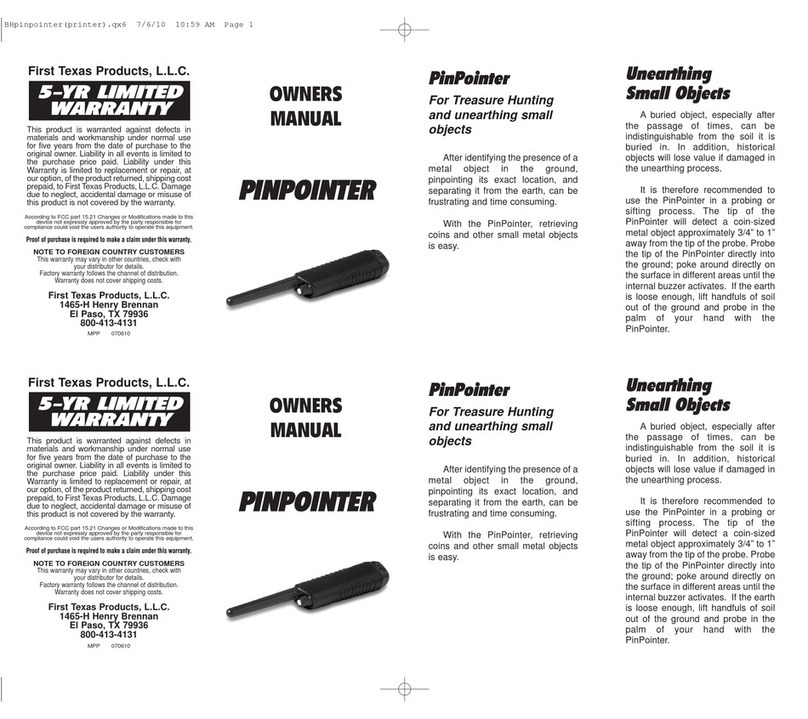
First Texas Products
First Texas Products PinPointer User manual
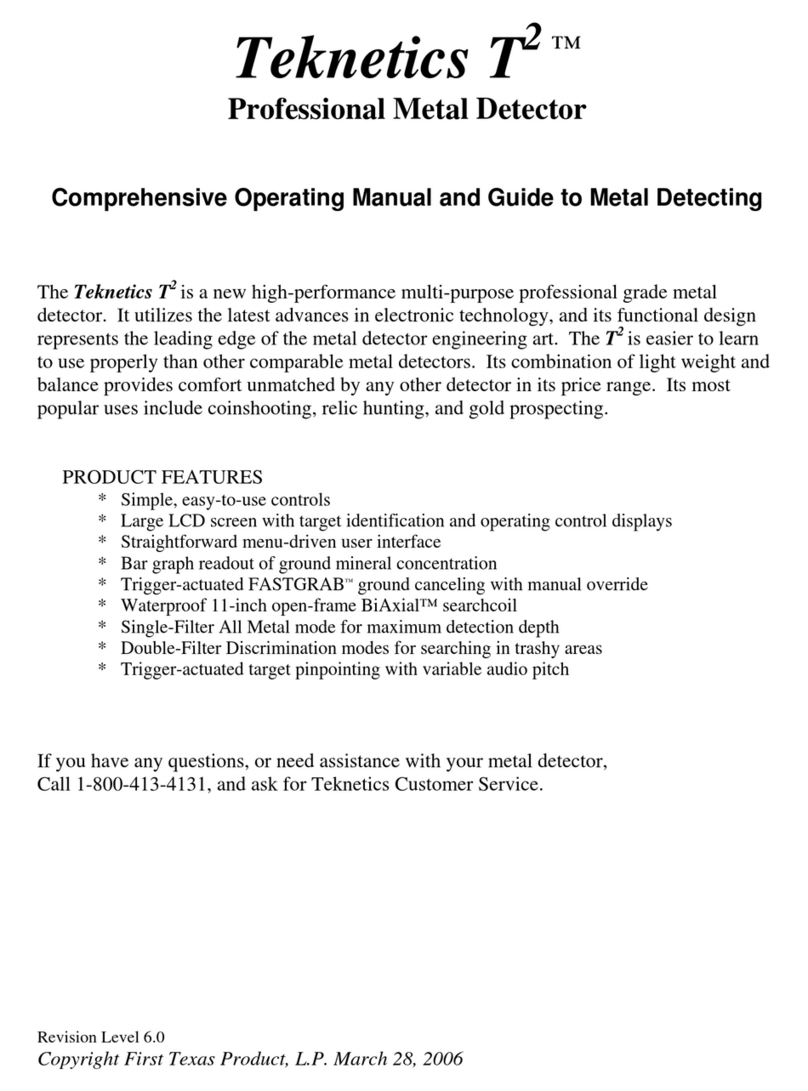
First Texas Products
First Texas Products Teknetics T2 User manual
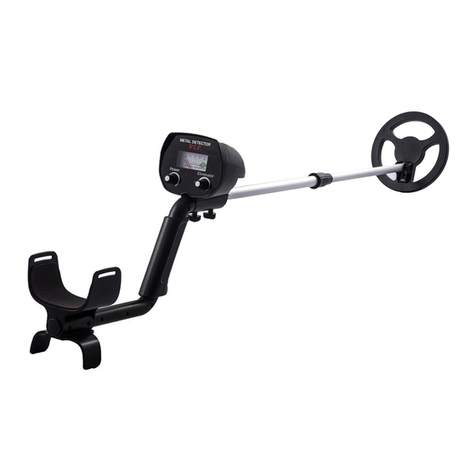
First Texas Products
First Texas Products VLF 2.1 User manual

First Texas Products
First Texas Products PINPOINTER User manual
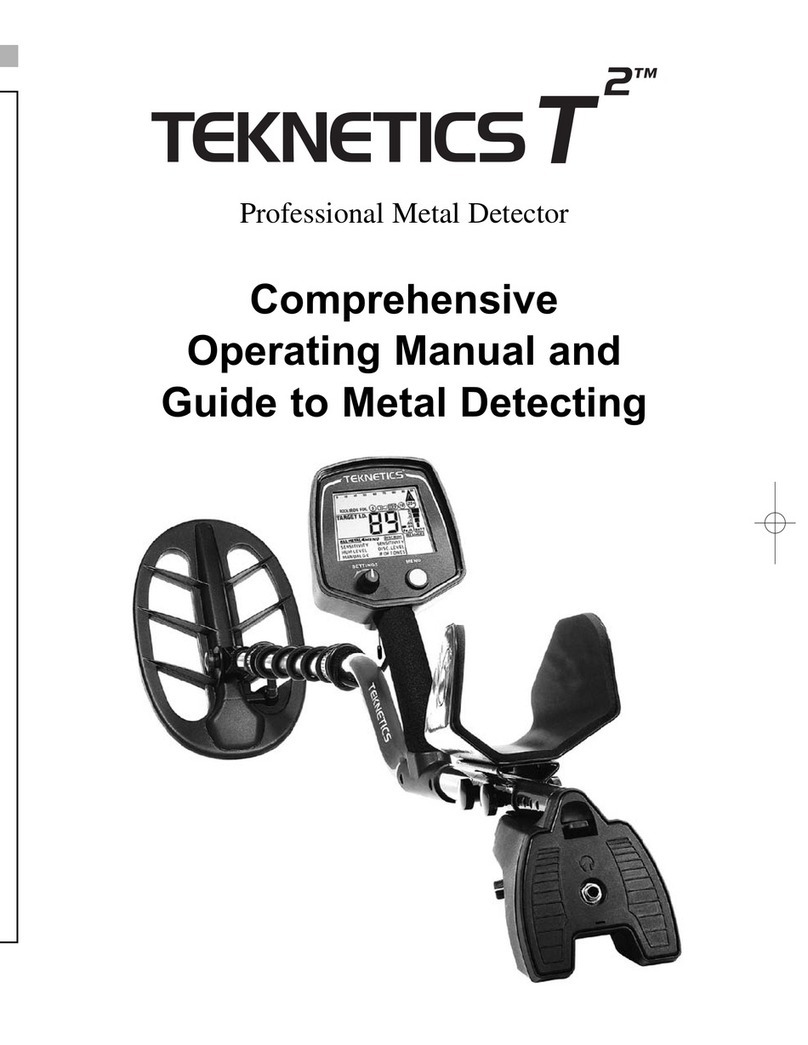
First Texas Products
First Texas Products Teknetics T2 User manual
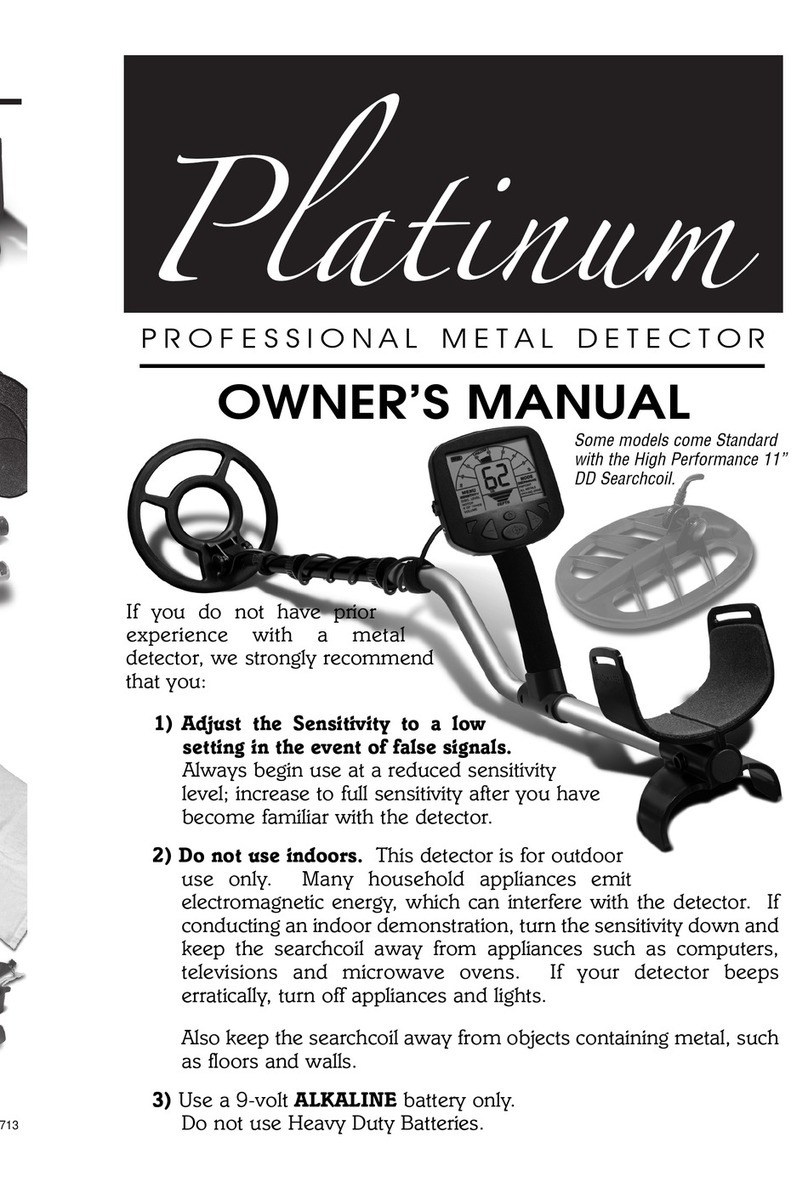
First Texas Products
First Texas Products Platinum User manual

First Texas Products
First Texas Products GOLD DIGGER User manual

First Texas Products
First Texas Products titanumCamo User manual

First Texas Products
First Texas Products Cabelas Platinum User manual

First Texas Products
First Texas Products Titanium Camo User manual
